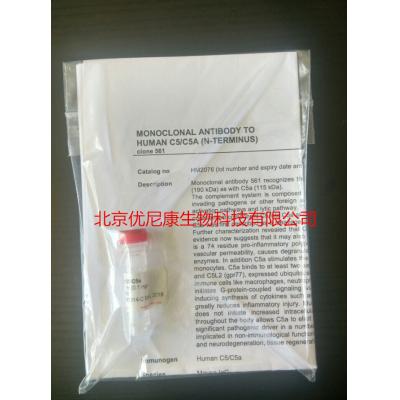- 欢迎来到北京优尼康生物科技有限公司
- |
-
商品分类

 010-64814275
010-64814275

 010-64814275
010-64814275

Catalog no HM2076 (lot number and expiry date are indicated on the label)
Description Monoclonal antibody 561 recognizes the N-terminus of C5. The antibody reacts both with intact C5
(190 kDa) as with C5a (115 kDa).
The complement system is composed of over 30 proteins, activated in response to tissue injury,invading pathogens or other foreign surfaces. The complement pathways can be divided in theactivation pathways and lytic pathway. The activation pathways lead via C3 to the cleavage of the fifth complement component C5 into C5a and C5b, resulting in activation of the lytic pahway
C5a was first described as a cleavage product of C5 with chemotactic and anaphylatoxic properties.Further characterization revealed that C5a is an essential part of the innate immune response and evidence now suggests that it may also play a role in adaptive immunity. Complement fragment C5a is a 74 residue pro-inflammatory polypeptide. C5a induces smooth muscle contraction, increasesvascular permeability, causes degranulation of mast cells and basophils, and release of lysosomal
enzymes. In addition C5a stimulates the directed migration of neutrophils, eosinophils, basophils and monocytes. C5a binds to at least two seven-transmembrane domain receptors, C5aR (C5R1, CD88)and C5L2 (gpr77), expressed ubiquitously on a wide variety of cells but particularly on the surface ofimmune cells like macrophages, neutrophils and T cells. The former is a well-established receptor that initiates G-protein-coupled signaling via mitogen-activated protein kinase pathways, thereby by
inducing synthesis of cytokines such as TNF-alpha, IL-1beta, IL-6 and IL-8. Its in vivo blockade greatly reduces inflammatory injury. Much less is known about C5L2, occupancy of which by C5a does not initiate increased intracellular Ca(2+).The widespread expression of C5a receptors throughout the body allows C5a to elicit a broad range of effects. Thus, C5a has been found to be a significant pathogenic driver in a number of immuno-inflammatory diseases. Nowadays C5a is also
implicated in non-immunological functions associated with developmental biology, CNS development and neurodegeneration, tissue regeneration, and haematopoiesis.